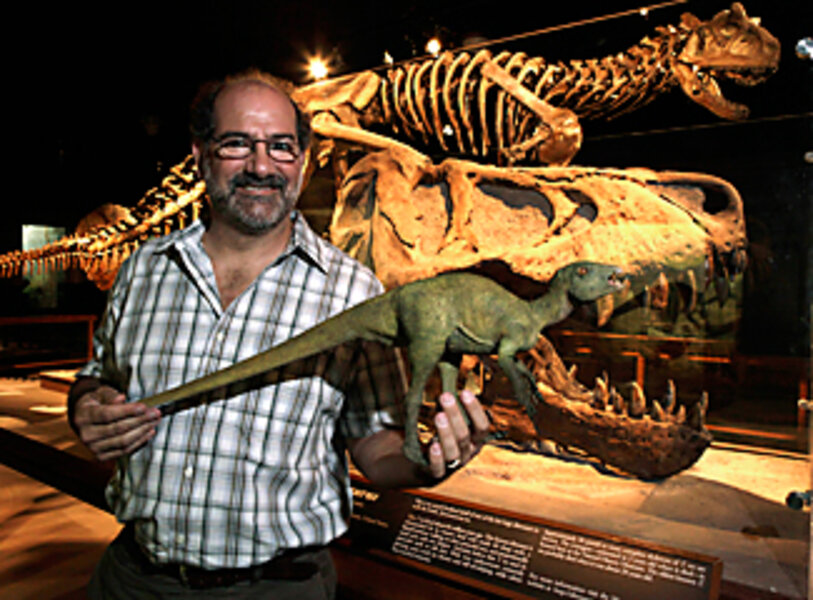North America's tiniest dinosaur weighed less than a toy poodle
Loading...
From a rock formation near Grand Junction, Colo., comes a tale of a dainty dinosaur.
Meet Fruitadens haagarorum, though it might as well be called Fifi. It's roughly the length of a toy poodle and a fraction of its weight.
It's the smallest dinosaur ever found in North America, according to an international team of scientists formally describing the creature this week. It stretches some 29 inches from beak to tail. In its day, it would have weighed in at just under two pounds.
The fossil remains of six of these animals have been languishing in storage at L.A.'s Museum of Natural History since they were unearthed between 1979 and the early 1980s. The creatures represent the latest examples of a broader group of prehistoric animals that are proving to be far more diverse than many people realized.
Fruitadens is the smallest known member of a group of dinosaurs known as ornithischia – bird-hipped dinosaurs that include behemoths such as Stegosaurus or Triceratops. For the most part, this group has been tagged as "plants eaters."
From what scientists can tell from the 150 million-year-old fossil's teeth, however, Fruitadens wasn't picky. It ate whatever it could find – veggies or meat.
For a long time, people divided dinosaurs into the meat-eaters and plant-eaters, observes Luis Chiappe, who heads the Dinosaur Institute at the Natural History Museum in Los Angeles and is a member of the team reporting the find. "Now we're finding that the division is not so clear cut."
Fruitadens, he says, is a good example of a "plant eater" that ate bugs or small reptiles, as well as plants. This ability to thrive on a range of foods may account for its longevity. The dinosaur's 100-million-year-long presence in the fossil record means "it's a very long-lived group," says Dr. Chiappe.
The incredible shrinking dino
Fruitadens' size is intriguing, because it bucks a general trend toward ever-larger bodies as dinosaurs evolved, explains Thomas Holtz Jr., a paleontologist at the University of Maryland in College Park.
When dinosaurs split into two major groups – the bird-hipped and the lizard-hipped – from a common ancestor, they were only about three to five feet long. Some bird-hipped ornithischia grew to sizable proportions – more than 50 feet long. But one subgroup, Heterodontosaurs, the family that Fruitadens belongs to, remained smaller than most. Fruitadens started out small and shrank with evolutionary time.
The pattern of starting at a length of 3 to 5 feet and getting bigger is a common trend among dinosaurs, says Dr. Holtz. But getting smaller from that starting point "seems to be pretty rare."
Why did Fruitadens take the path to puny?
Evolutionary pressures from predators could have prompted the creature to adopt the rabbit's approach: stay small, stay fleet, and hide – something that would have been tougher for Fruitadens' distant cousins, duck-billed plant-munchers that could grow up to 40 feet long.
Tree climbers?
Holtz offers up another intriguing possibility: Fruitadens may have been able to climb trees to avoid being eaten. He notes that as therapods – members of the lizard-hip gang – evolved into modern birds, the need to hunker down in trees, or glide from one to another on early forms of wings, favored smaller sizes.
As for Fruitadens, "there's nothing to keep these guys out of trees. After all, even goats can climb trees," he says. "These guys are built better for tree climbing than any goat ever was. So these could have been tree-dwelling, bird-hipped dinosaurs."
While even smaller dinosaurs have cropped up among the lizard-hipped group, Fruitadens may be reaching the lower limits for ornithischia.
It takes a sizable gut to digest plant material, explains Donald Henderson, curator of dinosaurs at the Royal Tyrrell Museum in Drumheller, Alberta, and a member of the research team reporting its results in the current issue of the Proceedings of the Royal Society B. And it's not clear one can get much smaller than Fruitadens and still keep roughage in the diet.
---
Follow us on Twitter.





